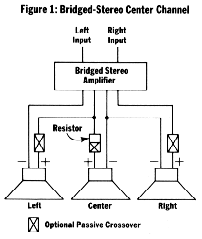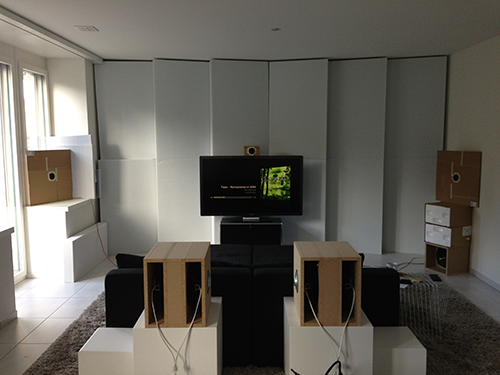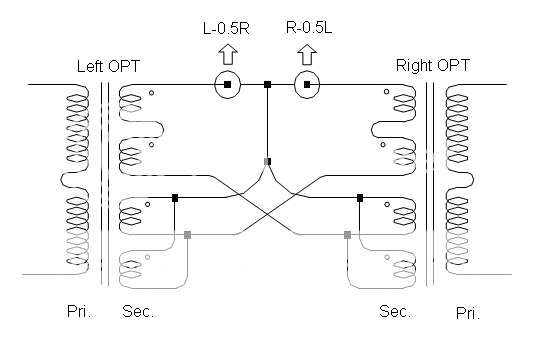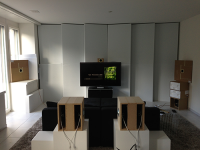Hi there,
Late to the party.
About the 6dB separation among channels, I'd like to share an experience. The number looks lousy, but to my hearing, it's quite different.
In a 3-ch linear matrix system with x=0.5, when the input signal is panned to the extreme left, then:
Ls= L
Cs= 0.5L
Rs= -0.5L
Listen to each unit closely, they're all playing. You'd hear the center and right are quieter, but not very much. Step back to the normal listening position, it's fun to hear the image goes far left and beyond the left speaker. At this moment, you'd swear there's absolutely no sound from center and right. It's one of the most interesting part of this thing.
-------
And, I've been planning a line level matrix for better flexibility in choice of amps and types of speakers.
Other than OP-amp based mixer circuit, are there any better solutions?
I tried cross-feeding the secondaries of R/L interstage transformers to each other to generate the partial subtractions. They're not buffered, so I'm not sure if it's robust enough to avoid interfereing with the upstream signals. Now I'm using this in bass section of active system only.
Late to the party.
About the 6dB separation among channels, I'd like to share an experience. The number looks lousy, but to my hearing, it's quite different.
In a 3-ch linear matrix system with x=0.5, when the input signal is panned to the extreme left, then:
Ls= L
Cs= 0.5L
Rs= -0.5L
Listen to each unit closely, they're all playing. You'd hear the center and right are quieter, but not very much. Step back to the normal listening position, it's fun to hear the image goes far left and beyond the left speaker. At this moment, you'd swear there's absolutely no sound from center and right. It's one of the most interesting part of this thing.
-------
And, I've been planning a line level matrix for better flexibility in choice of amps and types of speakers.
Other than OP-amp based mixer circuit, are there any better solutions?
I tried cross-feeding the secondaries of R/L interstage transformers to each other to generate the partial subtractions. They're not buffered, so I'm not sure if it's robust enough to avoid interfereing with the upstream signals. Now I'm using this in bass section of active system only.
Last edited:
About the 6dB separation among channels, I'd like to share an experience. The number looks lousy, but to my hearing, it's quite different.
I think 6dB is quite a lot of sound difference in perceptual sense.
For example, I have observed that just about 5dB difference between early reflections and direct sound is able to overrule precedence, or Haas, effect. That is, if reflections are 5dB higher in level than direct sound the perceived image is at the direction of the reflections. The literature does not suggest these kind of values but usually refer something like 12dB which is much bigger of course.
This happends in a small room acoustic space, so I guess most psychoacoustic studies have been done either by headphones or anechoic chamber.
Other than OP-amp based mixer circuit, are there any better solutions?
What was the problem of passive speaker wiring matrix ?
- Elias
Or the Dynaco method from the early 1960s
Is it that Hafler was working in Dynaco ?
What was the problem of passive speaker wiring matrix ?
I need more flexibility to build different speakers in the center and sides.
Different speakers have different impedance curves and efficiencies, so it's not ideal to take them into passive matrix directly. Compensations in those factors all cause some attenuation, which I don't like.
Also, not all amps are suitable for this task -- those with floating output stage like bridged class D, or high output impedance tube amps... etc.
I need more flexibility to build different speakers in the center and sides.
Different speakers have different impedance curves and efficiencies, so it's not ideal to take them into passive matrix directly. Compensations in those factors all cause some attenuation, which I don't like.
Also, not all amps are suitable for this task -- those with floating output stage like bridged class D, or high output impedance tube amps... etc.
Balanced output amps can be a problem with passive matrix, yes.
But why use different kind of speakers ? Ideally they should be identical at least in the bass and midrange. In top range treble I'm not sure if identical speakers are anymore required.
- Elias
If you have balanced in's and out's at the amps and source, a simple resistor matrix/mixer does the job, provided output impedance is low (<100R) and input impedance is high (>10k)Other than OP-amp based mixer circuit, are there any better solutions?
Feed the same polarity signals with R and the opposite polarity with 2R and tap of the output at the connection to get the "X-0.5Y" type of summing.
So Left_Out+ comes from Left_In+ via 750R and from Right_In via 1500R, and so on for all four combinations.
Center is just summing up like polarities with 2000R resistors, then dividing it down with a paralleled 4300R at the output (can be omitted if you have volume control at the amps).
You may want 200R trimmers at the junctions of the side-channel to trim out errors from non-zero output impedances and replace the 4k3 with 3k9+1k trimmer for a center channel level trim.
Easiest of course to provide the signals already as L-0.5R and R-0.5L (center is sum of it, can be done with resistors and amp volume) in software if your playback is PC-based. Matrix mixing plugins for the VST-Interface are available at no cost.
Last edited:
Balanced output amps can be a problem with passive matrix, yes.
Or, can be a benefit sometimes
If you're happy with matrix:
Ls = L
Cs = 0.5(L + R)
Rs = R
then can use this configuration with balanced output amplifier:

Apparently "Originally appeared in the May/June 1990 issue of Car Stereo Review magazine."
How To - Car Stereo - How To Install A Center Channel
However, this matrix may not be optimal.
- Elias
I'm just getting into 3-channel. I like listening near field and the stereo collapse was too bad for me with 2 speakers.
What do you guys think about focusing cash on the center channel and treating all others like 'surrounds'? Right now I'm using 3x upfiring 3" speakers in pipes (Demokrit style). I like it. I have some nice drivers lying around that I bought cheap from ebay (e.g. AL200) but not all paired up. Can't really afford to spend more on speakers at the moment. (Besides foil for making an AMT. )
)
Center is where the action should be, both for music and movies. And when guests come mono is more convenient anyway. (Also when I want to drag a speaker to the kitchen.)
I'm doing all my matrixing in Reaper.
What do you guys think about focusing cash on the center channel and treating all others like 'surrounds'? Right now I'm using 3x upfiring 3" speakers in pipes (Demokrit style). I like it. I have some nice drivers lying around that I bought cheap from ebay (e.g. AL200) but not all paired up. Can't really afford to spend more on speakers at the moment. (Besides foil for making an AMT.
Center is where the action should be, both for music and movies. And when guests come mono is more convenient anyway. (Also when I want to drag a speaker to the kitchen.)
I'm doing all my matrixing in Reaper.
What do you guys think about focusing cash on the center channel and treating all others like 'surrounds'?
Yes why not. In 70's it was popular.
Here for example Salora Ortoperspekta:
SALORA orthoperspecta
An externally hosted image should be here but it was not working when we last tested it.
I think it depends on the matrix coefficients if the speakers should be more identical or if center speaker can be much different. For the matrix that emphasises 'surround' signal the speakers could be different, but if matrix tries to spread images evenly then speakers should be the same.
- Elias
Thanks for the link. I've been enjoying matrixed center for the last week or so.
I've accepted that I'm always going to be building something new and doing them in pairs is not so convenient.
Also, only one excellent speaker is needed for recording impulses for headphone playback, where I think that the ultimate ceiling for fidelity is highest (at least at a reasonable cost).
I've accepted that I'm always going to be building something new and doing them in pairs is not so convenient.
Also, only one excellent speaker is needed for recording impulses for headphone playback, where I think that the ultimate ceiling for fidelity is highest (at least at a reasonable cost).
I think 6dB is quite a lot of sound difference in perceptual sense.
If I'm not mistaken, Francis Rumsey compared commercial upmixers with listening tests. All upmixers were judged to degrade the front sound stage compared to stereo. But different people may have different sensitivities for this, or just focus their attention to different aspects of the sound. For me, the 6 dB separation is not enough.
If I'm not mistaken, Francis Rumsey compared commercial upmixers with listening tests. All upmixers were judged to degrade the front sound stage compared to stereo.
Got a link to the document ?
What was used as criteria ?
I'm getting very good results with L and R placed about ±45° at the side walls (no center):

Just speculation, but I believe the good performance has to do with the way the speakers perceptually couple to the room's reflection pattern.
The level and timing of the contralateral reflection seems to be crucial.
Just speculation, but I believe the good performance has to do with the way the speakers perceptually couple to the room's reflection pattern.
The level and timing of the contralateral reflection seems to be crucial.
Attachments
Last edited:
Got a link to the document ?
What was used as criteria ?
This was mentioned in Toole's Sound Reproduction, page 289. I've just re-read the text. It says that "in general" the upmixers degraded the front sound stage, but it does not say that all of them did (my bad). Opinions varied somewhat according to that paragraph. The document is here (it's old by the way, 1999, so better algorithms have come along since then). I've been meaning to get a copy of it (and some other papers) from the university library here, but still haven't done that. Maybe that's a good new year's resolution
Nevertheless, the standard linear-matrix upmixing is not something I preferred when I heard it.
Last edited:
This was mentioned in Toole's Sound Reproduction, page 289. I've just re-read the text. It says that "in general" the upmixers degraded the front sound stage, but it does not say that all of them did (my bad). Opinions varied somewhat according to that paragraph. The document is here (it's old by the way, 1999, so better algorithms have come along since then). I've been meaning to get a copy of it (and some other papers) from the university library here, but still haven't done that. Maybe that's a good new year's resolutionToole also mentiones a more recent comparison by Choisel and Wickelmaier, 2007.
They are refering to 2 channel to 5.1 surround decoders. They are completely different than 2 channel to 3 speaker matrixes. Usually the are not linear but employ all kinds of nonlinear processing to try to create the missing information for 5 speakers.
However if we have 3 speakers and they are in front the situation is very much easier.
Nevertheless, the standard linear-matrix upmixing is not something I preferred when I heard it.
What is "standard" ? How many speakers ?
- Elias
I'm getting very good results with L and R placed about ±45° at the side walls (no center):
What about head turning ?
And what about off center listeners ?
Have you tried to compare with center speaker ?
What about head turning ?
And what about off center listeners ?
Both a no-go.
Have you tried to compare with center speaker ?
Not yet.
- Status
- This old topic is closed. If you want to reopen this topic, contact a moderator using the "Report Post" button.
- Home
- Loudspeakers
- Multi-Way
- Trinaural decoding equations for 3 speaker stereo matrix ?

